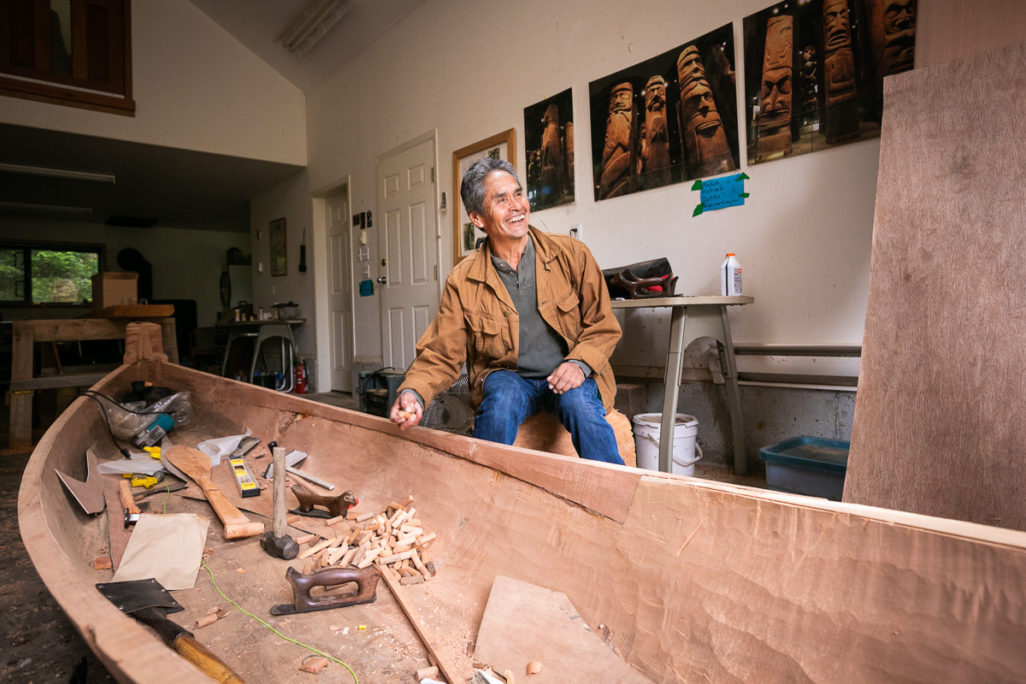A red cedar of so-called Avatar Grove near Port Renfrew. The stand of old growth is named T’l’oqwxwat by the Pacheedaht First Nation in whose unceded territory it grows. Under pressure to protect the grove, the BC government did so in 2012. Photo by TJ Watt, Ancient Forest Alliance.
Its future in doubt, no other tree has provided such abundance and identity for northwest peoples, or such habitat and carbon storage in the forest. First in a series.
Western red cedar takes hold of the senses. The Big Tree Trail boardwalk in protected Wah-Nah-Jus Hilth-hoo-is (Meares Island Tribal Park), a short boat ride from Tofino in Tla-o-qui-aht territory, is built of hand-split cedar planks redolent of the tree’s sweet oil. All around is shaggy cedar bark. Branches of feathering leaves dance in the breeze like a fringe skirt, curving upward at the ends as if giving thanks to the sun.
The trail leads to a sign marking “Hanging Garden.” From the decaying trunk of a 1,500-year-old, five-and-a-half-metre-wide red cedar — one of the largest and oldest life forms on Earth — lichens cling, hemlock and alder trees sprout, sword ferns unfurl, and bats and bears make their roosts. It may be slowly dying, but this tree is full of life.
Elsewhere in British Columbia, the red cedar is not so lucky. It’s having trouble adapting to capitalism and climate change, and living out its long life in a shifting forest.
Red cedar, proclaimed the official tree of B.C. in 1988, naturally grows in cool, moist climates from Northern California to Alaska and just west of the Rocky Mountains in one of the world’s only inland temperate rainforests. The tree is known to scientists as thuja plicata, but it goes by many names: Pacific red cedar, giant cedar, canoe cedar, giant arborvitae. Not a true cedar but a woody member of the cypress family, the Latin arbor-vitae may be most accurate; it translates to “tree of life.” Indigenous terms of affection include “mother” or “grandmother cedar,” “maker of rich women” and “long life maker.” The Nuu-chah-nulth name is huu-mis, huu signifying something long-lasting, perhaps across space and time.
While plant fossils show that a tree like red cedar has been growing around the northwest for as long as 50 million years, the species has only become widespread in the past 4,000 to 5,000 years — long after humans arrived in the region, says Richard Hebda, a paleontologist and adjunct associate professor at the University of Victoria.
Coast Salish Oral History tells that before there was red cedar, there was a generous man. Whenever his people were in need, the man gave food and clothing. Recognizing the man’s good work, the Creator declared that when he died, a red cedar would grow where he was buried and continue to provide for the people. Red cedar did just that, co-evolving with First Nations and helping them build sophisticated societies of unparalleled wealth, abundance and ingenuity.
Prior to cedar, canoes and homes on the coast were often built of Sitka spruce. But once abundant, mother cedar became the tree of choice at least 3,000 years ago. “Without the environment we live in, we are not who we are,” Hebda says.
There are several likely reasons for the shift. The wood is lightweight and straight-grained, making it easy to split without a saw. Perhaps more important, mature cedars produce a natural fungicide, thujaplicin, which prevents rot in moldy northwest climates.
The largest cedar trees offered their wood for homes, totem poles and canoes. These vessels were packed with cedar tools, from paddles and nets to hooks, lures and fishing floats. Cedar’s soft inner bark supplied clothing and comfort; it was woven into tunics, mats and blankets or shredded to make fluffy towels, diapers and sanitary pads.

Tla-o-qui-aht master canoe carver Joe Martin in his Tofino workshop next to a traditional dugout canoe he carved out of old-growth red cedar. Photo by TJ Watt, Ancient Forest Alliance.
Red cedar withes — vine-like appendages that swoop down from branches — were twisted into ropes so strong they could haul in 40-tonne whales. Roots were coiled into baskets tight enough to boil water. And the flat green leaves, which look like scaly braids, offered spiritual protection or calcium-rich medicine.
Babies were delivered into woven cedar cradles. Placenta was sometimes buried at the base of an old cedar to ensure long life. At the end of that life, people were laid to rest in cedar canoes and coffins, the tree embracing its people for eternity.
But industrial logging and climate change threaten to cut the tree’s future short, severing ancestral connections that spread wide and strong like roots. A central question may define red cedar’s fate: Can we learn to respect and protect the great giving tree before it’s too late?
(This is the first story in a series about the cedars of British Columbia, their vital role in this place’s ecologies and people working on ways to save them. Read the full story, published September 15 2020, on The Tyee. Then read part 2 and part 3.)